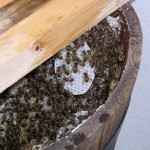
The bees in the top bar hive surprised me and are building their comb from the bottom up rather than from the top bars down. As a result, they are building comb across the top bars rather than using the top bars to guide their comb building. It will not be an easily manageable or inspectable or dividable hive, but it looks healthy. They are so strong and building up so well that my guess is they have raised a new queen, although I have not seen a queen.
-
Recent Posts
Recent Comments
- vicki delph on Honey Super Cell Experiment
- vicki shields on Honey Super Cell Experiment
- ljwestover on Honey Super Cell Experiment
- todd on Honey Super Cell Experiment
- Monika on Hot Wax Dipping Equipment
Archives
- May 2019
- February 2019
- February 2017
- January 2017
- August 2016
- June 2016
- May 2016
- March 2016
- July 2015
- June 2015
- May 2015
- April 2015
- October 2014
- August 2014
- July 2014
- June 2014
- May 2014
- April 2014
- February 2014
- December 2013
- October 2013
- September 2013
- August 2013
- July 2013
- June 2013
- May 2013
- April 2013
- March 2013
- February 2013
- December 2012
- June 2012
- May 2012
- April 2012
- March 2012
- December 2011
- November 2011
- October 2011
- September 2011
- August 2011
- July 2011
- June 2011
- May 2011
- April 2011
Categories
Meta

Great news that you look to officially have two japonica hives going now.
I have a question about Cernea and Japonica with reguards to SHB’s. Are they an issue in Asia/Japan yet? Is the reason we (in the States and Europe) have mites from Asia, from the import of Cernea species from Asia?
I have not seen or heard of small hive beetles in Japan yet. That does not mean they are not in the country. I will check on it and see what else I can find out as far as Japan and other parts of Asia go. For your second question, my best understanding is that the opposite is what is true. In other words, Apis cerana has not been imported into America, but European honey bees (EHB) were imported into Asia, and that is where the varroa mites jumped host from cerana to mellifera. It may have occurred somewhere in the former Soviet Union that is part of Asia where both mellifera and cerana overlap, or it could possibly have been somewhere else in Asia. Apis mellifera are bred and sold and shipped and moved around all over the world, so it is believed that the varroa mites in the U.S. originated from Apis mellifera (EHB) that were infested with varroa somewhere in Asia and then shipped to the U.S. So far as I know, there are not now nor have there ever been any Apis cerana shipped to the United States. I do not know of anyone who is keeping Apis cerana in the U.S.
Thanks! I would like to work with some of the sub-spieces that they use in India for honey prodection. So its a commies fault! lol
So are the EHB imports banned in Japan? I read some where that they were.
Did’nt know if some AHBs could be used for hobby use or commerical use in the states, as there seems to be issues and controvesry over the Russians (bees) and the purity.
Right, for the time being, EHB imports are banned in Japan. People with EHB are still keeping them, but the government is not allowing imports from other countries. By AHB’s, I assume you mean Africanized Honey Bees. They are all that is currently being kept in Mexico, and I understand they are doing very well with them. It’s just the “initial wave” of Africanized bees that seem to cause most of the problems. Africanized honey bees can be selected for gentleness too, and I have read that in Africa the AHB’s that beekeepers have are great.
Sorry, I forgot that AHB does stand for Africanized Honey Bees. I was using it in terms of Asian Honey Bees, I guess I should have used AC…
Yes, from what I am reading also, that the AHB is inter-breeding with EHB and is doing very well. Just the media and their hype had people scared about killer bees.
I was refering to the Indian species of honey bee, that has some small scale commerical use.
I was helping a grad student at the University of Arkansas, she was doing research on SHBs and she found a pathogen in 5 SHBs out of 350 plus. 2 of them were from the samples that I sent. Have you come accross anything like this? She has asked for a sample of my bees and for SHBs also to see if it is something that is from the bees or is something that can spread from SHBs to the Bees.